Intel Xeon Gold 6248R Benchmarks
For this exercise, we are using our legacy Linux-Bench scripts which help us see cross-platform “least common denominator” results we have been using for years as well as several results from our updated Linux-Bench2 scripts. Starting with our 2nd Generation Intel Xeon Scalable benchmarks, we are adding a number of our workload testing features to the mix as the next evolution of our platform.
At this point, our benchmarking sessions take days to run and we are generating well over a thousand data points. We are also running workloads for software companies that want to see how their software works on the latest hardware. As a result, this is a small sample of the data we are collecting and can share publicly. Our position is always that we are happy to provide some free data but we also have services to let companies run their own workloads in our lab, such as with our DemoEval service. What we do provide is an extremely controlled environment where we know every step is exactly the same and each run is done in a real-world data center, not a test bench.
We are going to show off a few results, and highlight a number of interesting data points in this article.
Python Linux 4.4.2 Kernel Compile Benchmark
This is one of the most requested benchmarks for STH over the past few years. The task was simple, we have a standard configuration file, the Linux 4.4.2 kernel from kernel.org, and make the standard auto-generated configuration utilizing every thread in the system. We are expressing results in terms of compiles per hour to make the results easier to read:
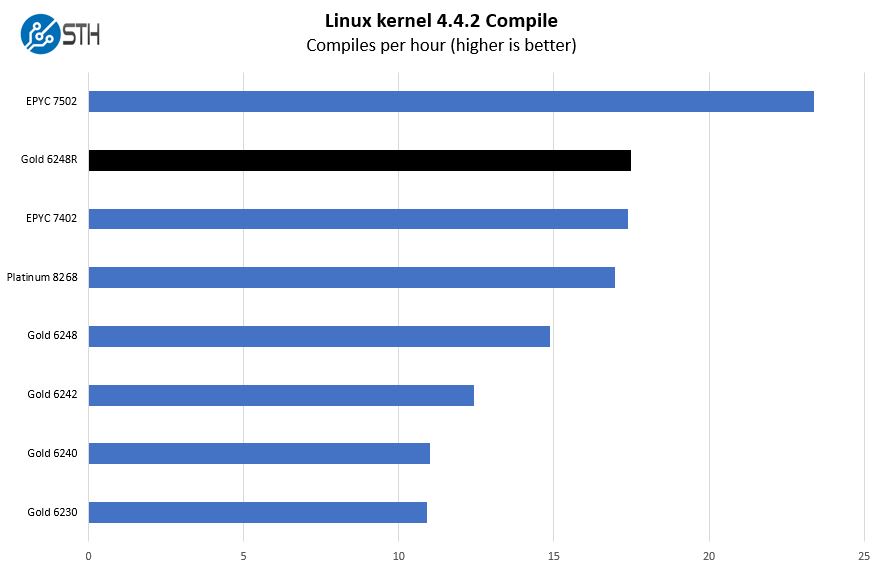
Here, the Xeon Gold 6248R is very close to the AMD EPYC 7402 in terms of performance. As a quick sense of scale comparing Intel and AMD here, the AMD EPYC 7402 is a 24-core processor at around $1800 while the AMD EPYC 7502 is a 32-core processor around $2600. That makes the EPYC 7502 the list price competitor to the Gold 6248R but the EPYC 7402 the core count competitor.
c-ray 1.1 Performance
We have been using c-ray for our performance testing for years now. It is a ray tracing benchmark that is extremely popular to show differences in processors under multi-threaded workloads. We are going to use our 8K results which work well at this end of the performance spectrum.
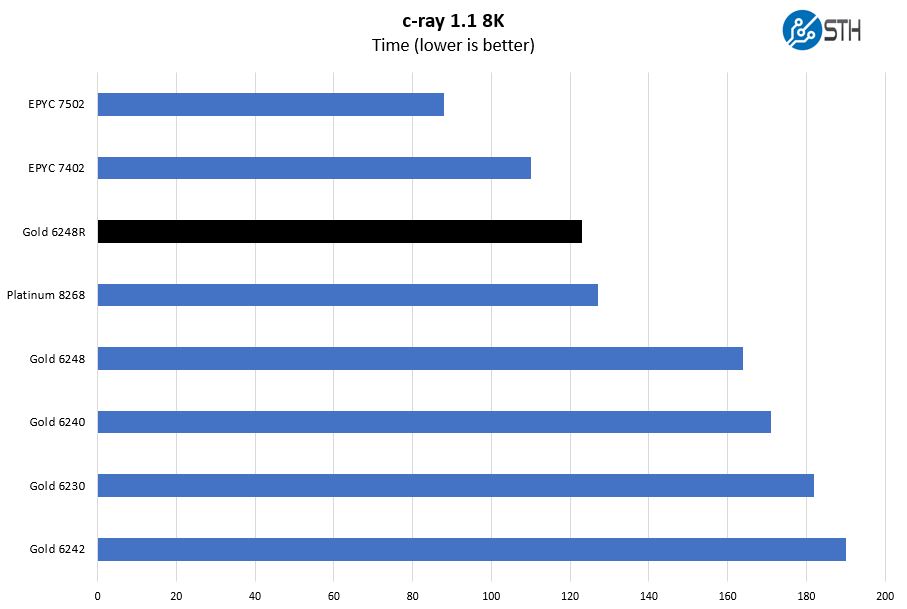
This test tends to highly favor the AMD core and cache hierarchy. That is one reason, for example, that AMD tends to use benchmarks such as Cinebench on the workstation marketing side. Here the 24-core AMD EPYC 7402 performs better than its Intel counterpart which is what we would expect on this test.
7-zip Compression Performance
7-zip is a widely used compression/ decompression program that works cross-platform. We started using the program during our early days with Windows testing. It is now part of Linux-Bench.
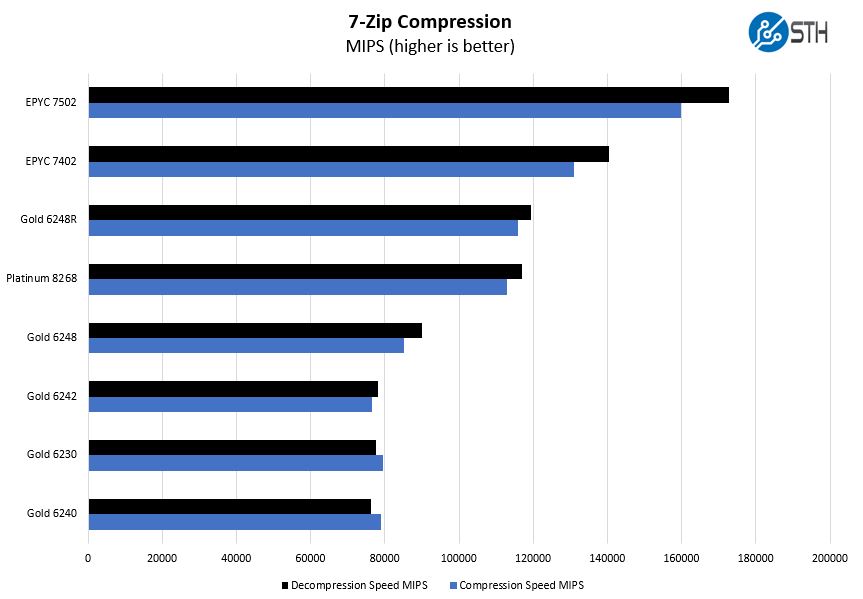
We wanted to take a moment to show just how big of a delta there is over the Intel Xeon Gold 6248. Effectively, this is a massive jump in performance at this Xeon Gold SKU level.
NAMD Performance
NAMD is a molecular modeling benchmark developed by the Theoretical and Computational Biophysics Group in the Beckman Institute for Advanced Science and Technology at the University of Illinois at Urbana-Champaign. More information on the benchmark can be found here. With GROMACS we have been working hard to support AVX-512 and AVX2 architectures. Here are the comparison results for the legacy data set:
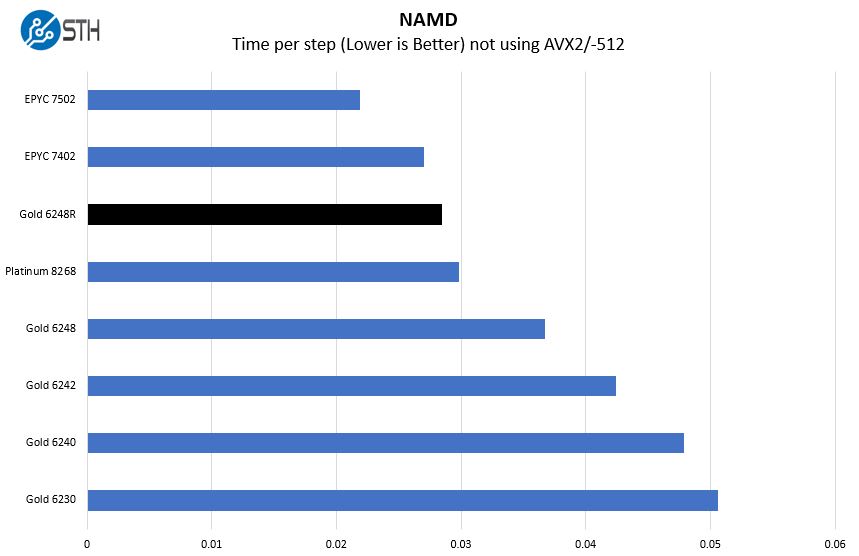
We also wanted to point out the impact of the clock speed boosts over the Intel Xeon Platinum 8268 it is not always by a large margin, but it seems to be enough to keep the Xeon Gold 6248R ahead in our testing. Again, this is comparing a Xeon Platinum that cost more than twice as much at the Cascade Lake-SP launch a year ago.
Sysbench CPU test
Sysbench is another one of those widely used Linux benchmarks. We specifically are using the CPU test, not the OLTP test that we use for some storage testing.
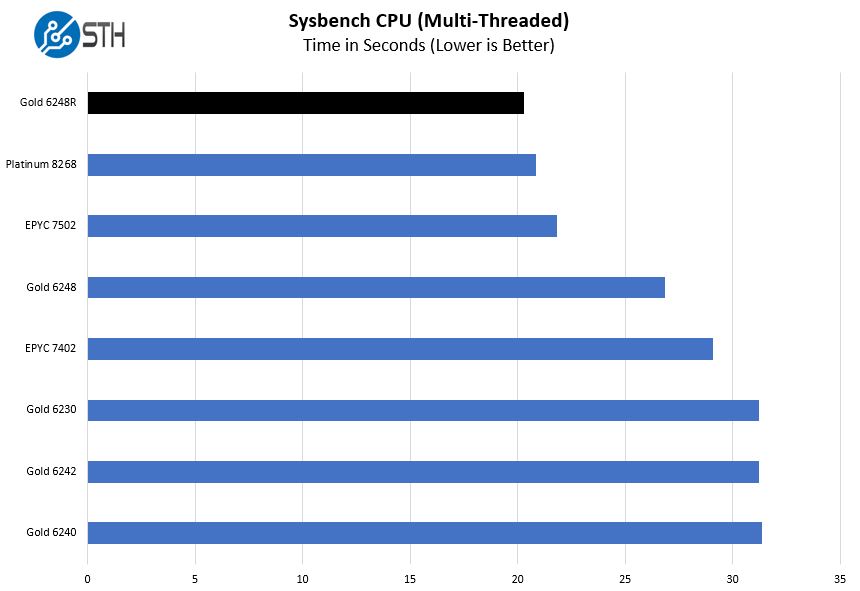
Here we see Intel take the top spot, even over the AMD EPYC 7502 32-core part. High clock speeds can make up for fewer cores in many instances.
OpenSSL Performance
OpenSSL is widely used to secure communications between servers. This is an important protocol in many server stacks. We first look at our sign tests:
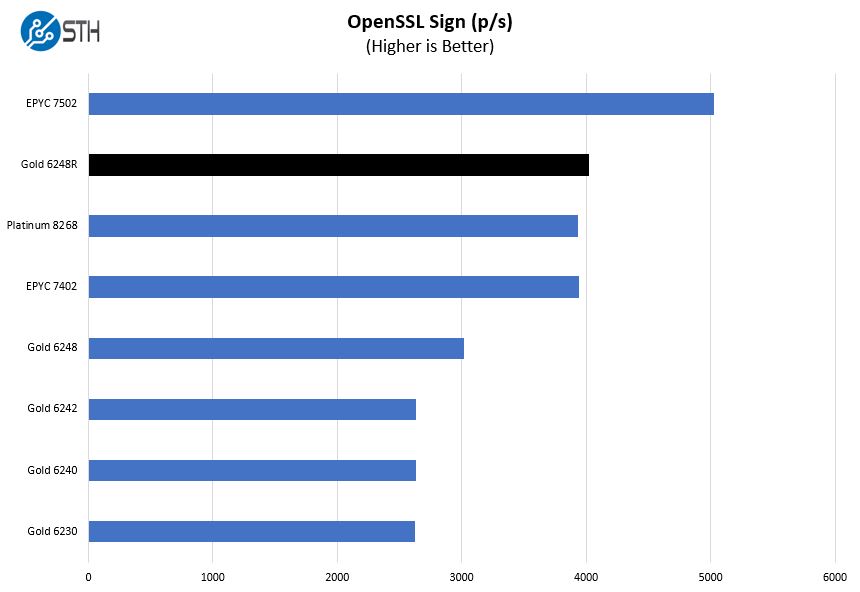
Here are the verify results:
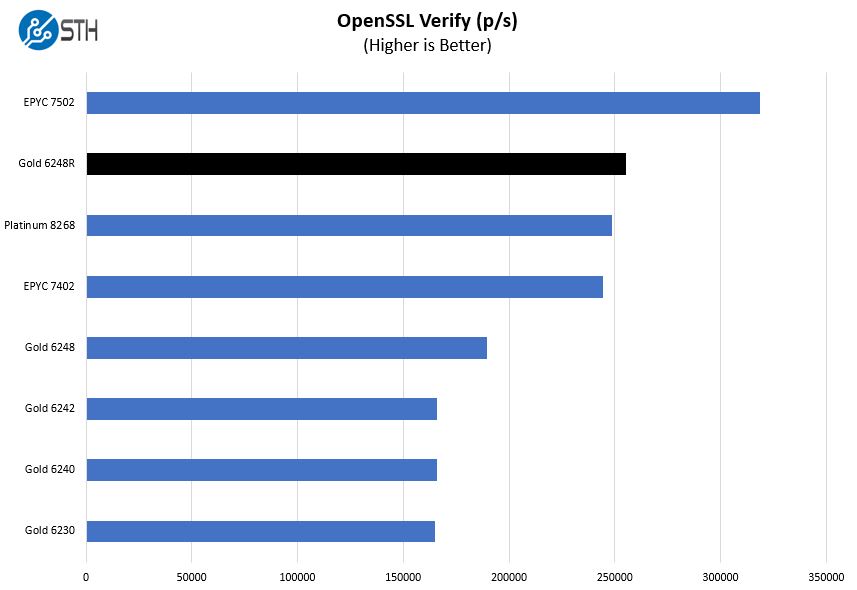
On the OpenSSL test, we find the Intel Xeon Gold 6248R out-performing the AMD EPYC 7402 on a core-for-core basis. Still, we are seeing a fairly massive jump in performance generationally.
UnixBench Dhrystone 2 and Whetstone Benchmarks
Some of the longest-running tests at STH are the venerable UnixBench 5.1.3 Dhrystone 2 and Whetstone results. They are certainly aging, however, we constantly get requests for them, and many angry notes when we leave them out. UnixBench is widely used so we are including it in this data set. Here are the Dhrystone 2 results:
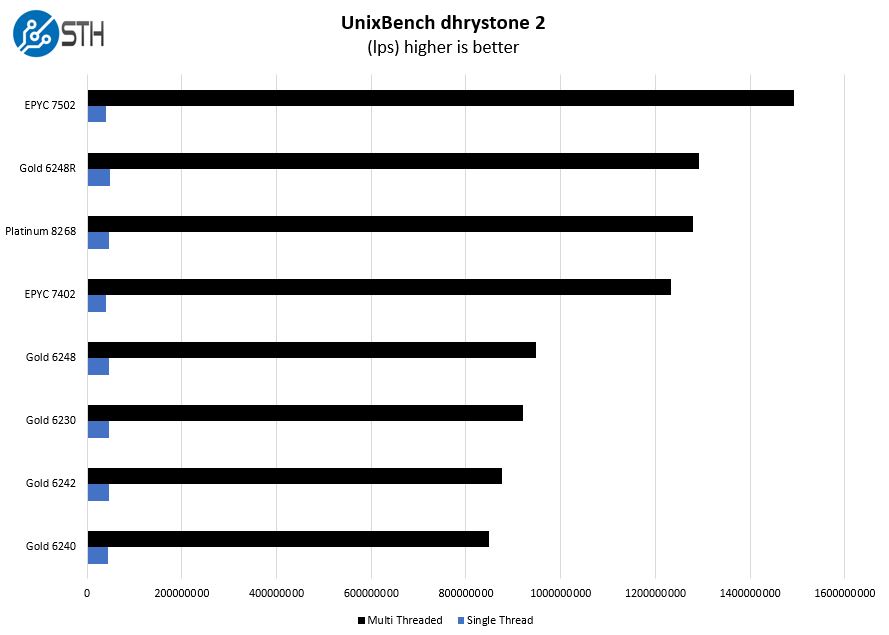
Here are the whetstone results:
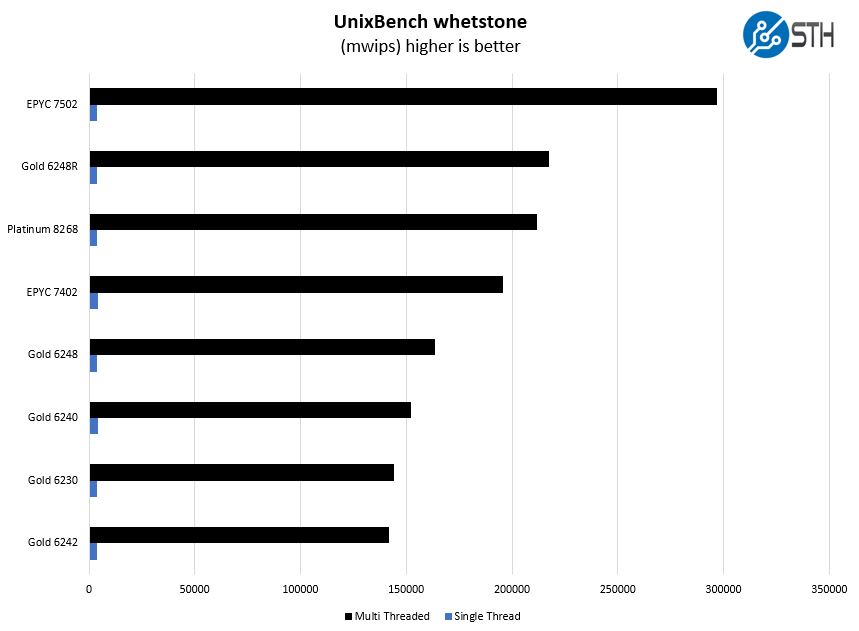
From these charts, one can clearly see that the new “R” part presents a huge value leap over the previous-generation Xeon Gold 6400 series. We also see Intel out-perform AMD on a core-for-core basis again.
GROMACS STH Medium AVX2/ AVX-512 Enabled
We have a small GROMACS molecule simulation we previewed in the first AMD EPYC 7601 Linux benchmarks piece. In Linux-Bench2 we are using our “small” case which is appropriate for single-socket servers. Our GROMACS test will use the AVX-512 and AVX2 extensions if available.
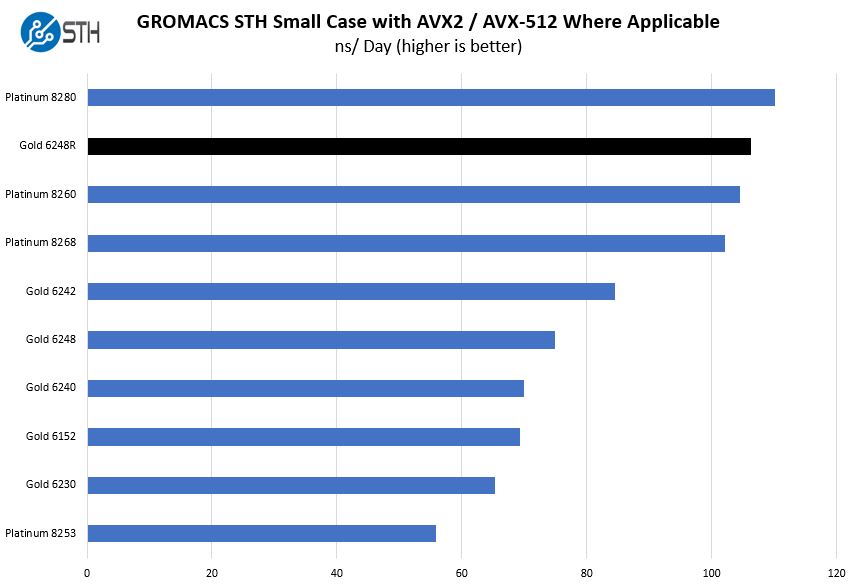
Taking a step back and looking at what AVX-512 can do for a chip, we see something that is very interesting here. The 205W TDP means that we see a massive increase in AVX-512 performance. We are not quite at Intel Xeon Platinum 8280 levels, but we are seeing higher performance per core than the previous top-end $10,000 SKU.
Chess Benchmarking
Chess is an interesting use case since it has almost unlimited complexity. Over the years, we have received a number of requests to bring back chess benchmarking. We have been profiling systems and now use the results in our mainstream reviews:
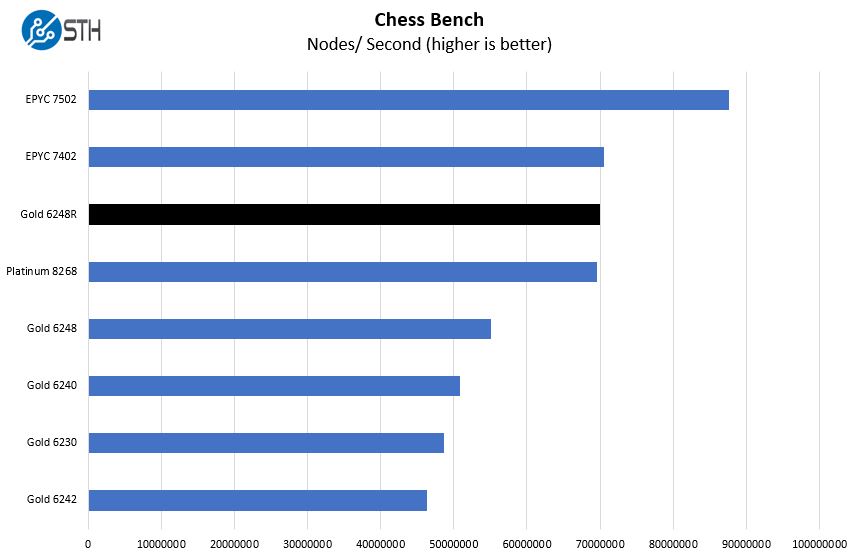
On the chess benchmark, we see The Xeon Gold 6248R again in a dead heat with the AMD EPYC 7402.
Next, we are going to discuss market positioning and impact before getting to our final words.
Intel Xeon Gold 6248R Market Positioning
Thes chips are not released in a vacuum instead, they have competition on both the Intel and AMD sides. When you purchase a server and select a CPU, it is important to see the value of a platform versus its competitors. Here is a look at the overall competitive landscape:
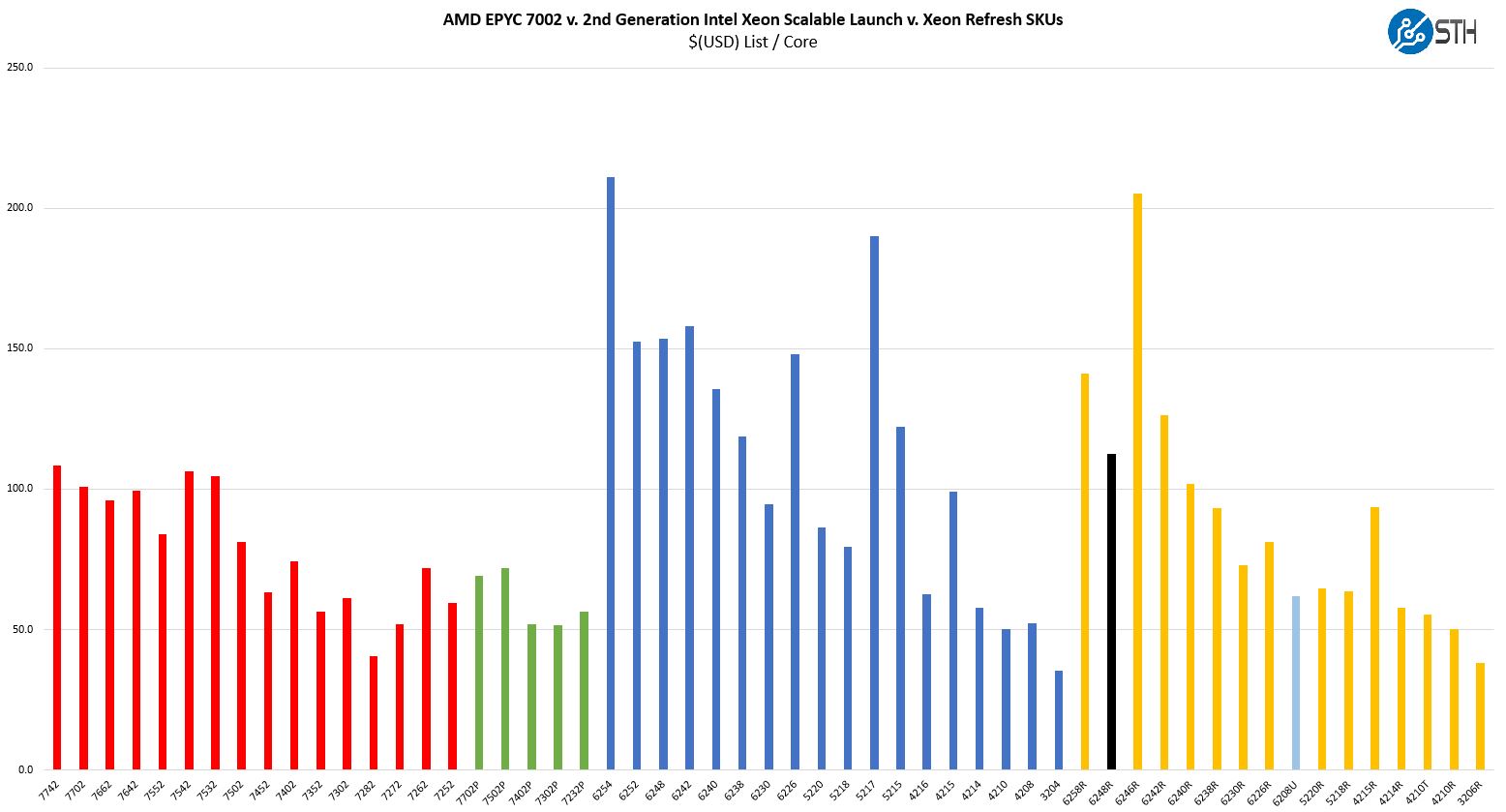
We are going to dive into the impact of this char next in our discussion of different competitive vectors.
Intel Xeon Gold 6248R v. Intel Alternatives
This is a hard part to place in the lineup. Not because the performance is not as expected. Indeed, performance meets what we would expect from a part with similar specs. Given Intel’s plethora of chip options, the competition a Xeon Gold 6248R faces comes largely within.
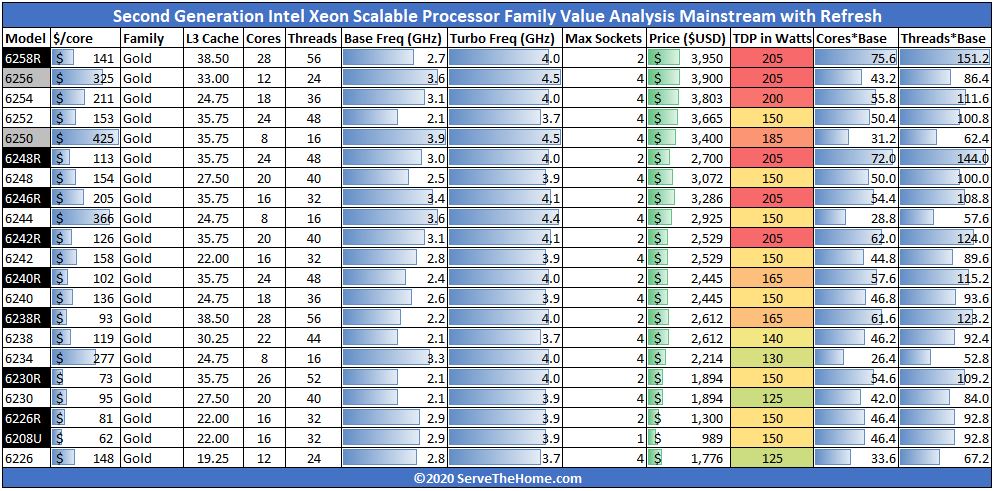
Although this may seem like a minor upgrade with the simple addition of the “R” it is far from it. Intel effectively released these refresh CPUs at a level that they are much faster than the previous generation and we are not looking at a 10% increase. Intel is fully 20-30% higher than the previous generation and that led to the Intel Cooper Lake Rationalization and the decision not to release Cooper Lake next for the mainstream “Whitley” platform. Effectively, Intel is using these refresh SKUs as a new CPU generation for existing mainstream server platforms.
In terms of competition, the previous generation offers little for the mainstream 2-socket market. It would be hard to purchase an Intel Xeon Gold 6252 at almost $1000 more for the same core count and significantly lower clock speeds. The Intel Xeon Gold 6240R is priced at $255 less per chip offering lower clock speeds making it a potential competitor. Perhaps the most interesting refresh competition will come from the Xeon Gold 6238R a lower-clocked but 28 core part and the Xeon Gold 2630R which is $800 less for 26 lower-clocked cores. Intel has compressed the price ranges a lot more than in the previous generation.
Intel Xeon Gold 6248R v. AMD EPYC 7002 “Rome”
With the Intel Xeon Gold 6248R, the world has changed with its competition to AMD EPYC 7002 “Rome” processors. Here we are normalizing some of our results to the Intel Xeon Gold 6248 baseline as 1.0.
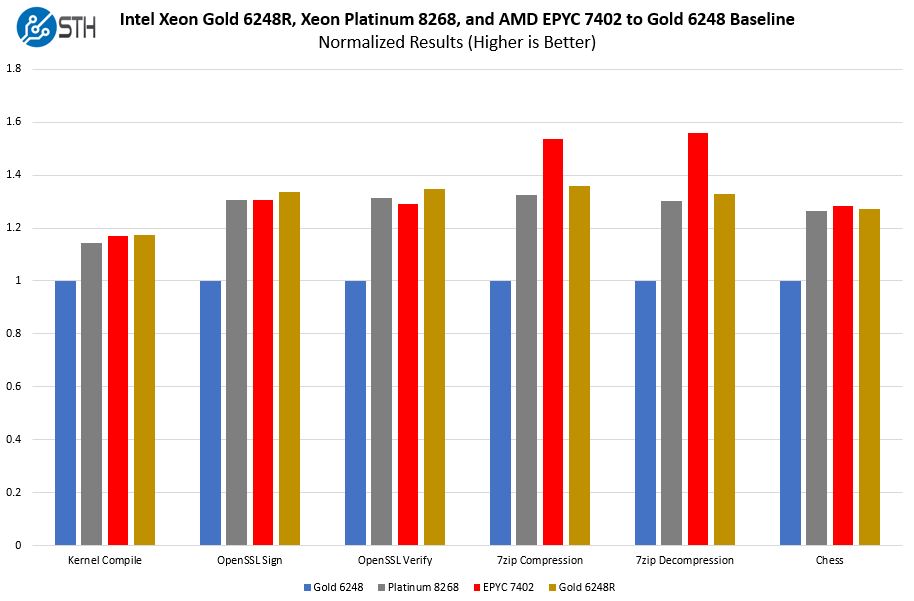
As you can see, the Intel Xeon Platinum 8268 was very competitive, but the price was much higher making it less attractive at 24-cores than the EPYC 7402. Now, the AMD EPYC 7402 is a sub-$1800 part, so when we normalize performance per dollar to the Intel Xeon Gold 6248R we see AMD still has a lead:
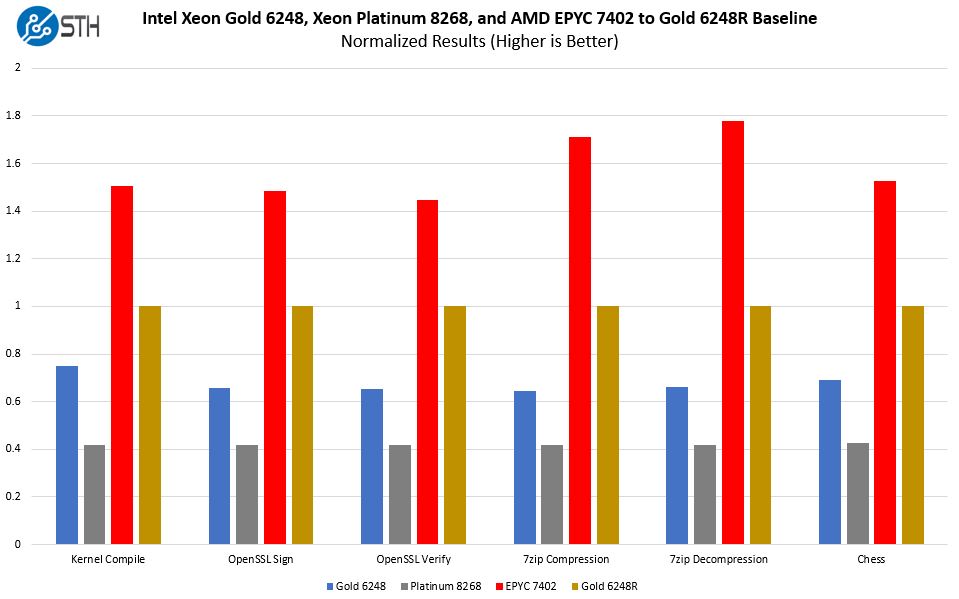
At the same time, Intel is now thoroughly in the range where with smaller discounts it can offer a competitively performing part, at a close enough price to keep buyers who were considering switching. For incumbents, pricing for your offerings just needs to be “close enough” to avoid a mass exodus to your upstart competitor.
There are a few costs that one overlooks when looking at CPU prices only. For example, a ~$50 “Lewisburg” C62x PCH goes in every dual-socket Intel Xeon Scalable server. Intel also sells a ton of NICs and SSDs that go to big OEMs and end customers. Intel has FPGAs and other accelerators as well as Optane DCPMM.
Intel’s strategy is to create a giant silicon portfolio, then be able to bundle across. For AMD, it can have a better CPU, but if you have $2000 of CPUs in a server and $20,000 of SSD storage, a $500 NIC, and potentially thousands of dollars of memory, Intel can make up CPU discounting on the bundle. It can also do this at a higher-level giving performance incentives across its portfolios to OEMs and channel partners.
Intel also has AVX-512 and VNNI (DL Boost) so it can claim instruction-level features that AMD does not have.
AMD’s strengths are in PCIe Gen4 and having more memory bandwidth and capacity for mainstream SKUs. It also has an architecture that utilizes (relatively) a ton of cache which can make up for a lot of the clock speed delta Intel is pushing in this generation. AMD is the better value looking at CPUs, but Intel is playing this game on a total silicon TAM basis not on a CPU-for-CPU basis.
If you do not use DCPMM, AVX-512, DL Boost, Intel SSDs, and Intel NICs, then AMD is a much stronger competitor.
Final Words
The big Intel Xeon Gold 6248R shift here shows that Intel is listening and responding in the market. It is essentially bringing $6,300 performance down to $2,700 and throwing in slightly higher clocks and performance in the process.
We have no hesitation telling our readers that if they are buying Intel Xeon Scalable servers, first or second generation, that they should look at the Xeon Gold 6248R instead of what they have been buying. Not taking advantage of these refresh SKUs is an enormous opportunity lost. For those looking to maintain feature parity, the instruction sets are the same for the Gold 6248R and Gold 6248 so virtual machine live migration can happen without issue with this new generation.
For those looking to the AMD EPYC lineup, AMD still offers plenty of performance and better value in most areas on a price/ performance basis. If you do not need the additional features of the Xeons, want features from AMD in terms of platform I/O expandability, and do not get bundled pricing from Intel, the AMD EPYC 7402 and EPYC 7502 still offer an enormous value proposition, and even more in single-socket configurations.
This is a monumental change at the Intel Xeon Gold 6248(R) level and one that we expect our readers to take advantage of.




Still a pretty good margin for Intel (cost price ~$400, list price ~$2,700).
Good to see that Intel is also lowering the prices for SMB customers (list price) and not only focussing on corperate customers who get hugh discounts(400% being no excetion these days to keep market share).
Great job, STH!
Could you run also the SPECworkstation benchmark as you did for other CPUs?
These CPUs are used in server environment, but also for workstations…
Thanks
I think the R suffix better denotes “RENAME” rather than “REFRESH”. It does not look like Intel has done an extensive research in making the R Series SKUs. Rather I will see it as Intel, to protect their share of market renamed Platinum class SKUs and sell it at a much lower price as that of Gold. However, as you mentioned bringing a $6300 part performance to $2700 part will be a good deal for customers to explore but I will say with a caution, Intel has released many short term SKU without appropriate future plans.
It would be great if you can run Intel Optimized HPL publish the sustained numbers as a comparison for 6248 and 6248R. I overheard the sustained performance are comparably not so great.